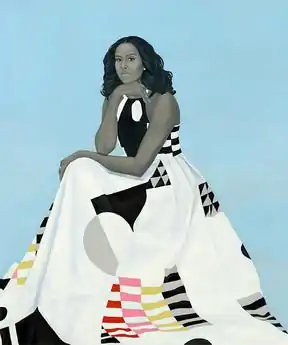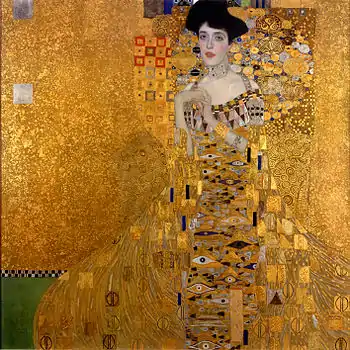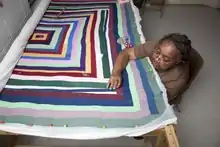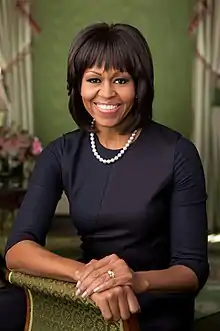First Lady Michelle Obama (painting)
First Lady Michelle Obama, initially titled Michelle LaVaughn Robinson Obama, is a portrait of former First Lady of the United States Michelle Obama, painted by the artist Amy Sherald. Unveiled in 2018, it hangs in the National Portrait Gallery (NPG) in Washington, D.C. The six-by-five-foot (1.8 by 1.5 m) oil-on-linen painting shows Obama, rendered in Sherald's signature grisaille, resting her chin lightly on her hand, as a geometric print dress flows outward filling the frame against a sky-blue background.
| First Lady Michelle Obama | |
|---|---|
| Portrait of Michelle Obama | |
 | |
| Artist | Amy Sherald |
| Year | 2018 |
| Medium | oil paint, linen |
| Subject | Michelle Obama |
| Dimensions | 183.2 cm (72.1 in) × 152.7 cm (60.1 in) × 7 cm (2.8 in) |
| Location | National Portrait Gallery |
| Accession No. | PA/NPG.18-57 |
| Website | npg |
Praised by critics and immensely popular with museum visitors, the National Portrait Gallery's attendance doubled in the two years after the unveiling of Sherald's portrait along with Kehinde Wiley's portrait of President Barack Obama. Museum director Kim Sajet credits Sherald and Wiley with reinvigorating the genre of portrait painting. Sherald and Wiley were also the first African American artists to receive commissions for National Portrait Gallery presidential portraits.
Background
In 2017, for her portrait for the National Portrait Gallery, former First Lady Michelle Obama chose the artist Amy Sherald, who like Obama is African American.[1] Both the President and First Lady met with Sherald as a candidate to paint their respective portraits, but Sherald and Michelle Obama had an immediate connection. Obama described the meeting:
Within the first few minutes of our conversation, I knew she was the one for me. And maybe it was the moment she came in and she looked at Barack and she said, 'Well, Mr. President, I'm really excited to be here, and I know I'm being considered for both portraits,' she said, 'but, Mrs. Obama' – she physically turned to me and she said – 'I'm really hoping you and I can work together.'[2]
Sherald, who is from Columbus, Georgia, and then living in Baltimore,[1] was 43 and a rising star in the art world. Just a few years prior she had still been waiting tables to pay the bills,[1] but in 2016 her painting Miss Everything (Unsuppressed Deliverance) won the National Portrait Gallery's Outwin Boochever Portrait Competition.[3] The citation praised her "innovative, dynamic portraits that, through color and form, confront the psychological effects of stereotypical imagery on African-American subjects". Sherald was the first woman and first African-American to win the competition.[4][5] Sherald and Kehinde Wiley, the artist President Barack Obama selected for his portrait, became the first African American artists commissioned to paint presidential portraits for the National Portrait Gallery.[6]
Obama, with input from Sherald,[7] also selected her dress for the sitting, choosing a design from the Spring 2017 collection of the line Milly by fashion designer Michelle Smith.[8] Obama and her stylist Meredith Koop had worked with Smith previously, including for an Essence magazine cover shoot.[9] Smith pulled the dress from production so it would be unique to Obama[10] and worked with the team remotely to tailor the design for her,[9] but the final wardrobe selection was not revealed until the painting's unveiling ceremony at the National Portrait Gallery.[11]
Creative process
Sherald, whose signature grayscale is influenced in part by the black-and-white photographs of Black people that W.E.B. DuBois showed at the 1900 Paris Exposition,[12] spent two 90-minute sessions photographing Obama, then painted from the photographs.[13] Sherald noted she felt struck by how much Obama resembled her daughter Malia in Sherald's photographs.[13]
While Sherald typically does not take individual portrait commissions[14] and instead selects sitters for her portraits from the people she meets in her everyday life, she felt Obama shared the relatability and authentic presence of her past sitters: common people "just being themselves." Sherald sought to portray these traits, significant as the qualities that made Obama feel accessible to ordinary people.[7]
The Obamas as well as officials from the National Portrait Gallery saw photographs of the painting while it was still a work in progress, but made no requests for adjustments to the portrait, leaving complete creative control to Sherald.[13][7]
Sherald initially titled the painting Michelle LaVaughn Robinson Obama.[13]
Style

The portrait is a large oil painting on linen, standing 6 ft (1.8 m) tall and 5 ft (1.5 m) wide.[15]
Obama's face, as well as her visible arms and hands, are stylized in shades of gray, an artistic technique known as grisaille,[16] a key theme in works by Sherald. Of the choice to use grayscale instead of color in painting skin, Sherald said the intention was to resist reductive readings of race that placed the sitter in a box: "To me when you see brown skin, it tends to codify something. So through the gray you're almost allowed to look past that into the real person."[2] The background is a simple blue evoking American folk art.
Art and architecture critic Philip Kennicott described Sherald's portrait as portraying Obama with "a curious mix of confidence and vulnerability." He described the juxtaposition of Obama's face, painted "in the gray tones of an old black-and-white photograph," with the vibrant "robin's egg blue background" as a technique Sherald often uses to impart "a heightened sense of the surreal."[17]
The dress dominates the work as a mountain-like triangle.[16] A full-length halter gown with a modern geometric pattern from the American womenswear line Milly,[18] the dress struck designer Michelle Smith as appropriate to the occasion both because its style reflected the way Obama dresses in her daily life and because, to Smith, the material and design symbolized Obama's contemporary sensibilities in her life overall: "It's made of a stretch cotton poplin print in a clean, minimal, geometric print without a reference to anything past or nostalgic, which gives the dress a very forward-thinking sensibility – this is very Michelle Obama."[8] Elements of the portrait have been noted by art critics to have been influenced by Gustav Klimt, in particular the Portrait of Adele Bloch-Bauer I.[19] One commentator noted the similarity to fashion designed by Klimt's muse Emilie Louise Flöge.[20]

By contrast Sherald said the dress reminded her of the works of 20th century Dutch painter Piet Mondrian and the African-American quilting tradition of Gee's Bend, Alabama, a community descended from formerly enslaved African Americans.[21][16] Sherald felt it echoed the Gee's Bend tradition of "composing quilts in geometries that transform clothes and fabric remnants into masterpieces."[22]
Writing in The New Yorker, art critic Peter Schjeldahl remarked on his first impression, viewing the piece in reproduction, of the "immense cotton gown [...] which fills most of the canvas that isn't taken up by a light-blue ground." Initially it seemed to him to be "an overwhelming of the wearer by the worn." His impression changed completely after seeing the work in person and he urged readers: "You must – and I mean absolutely have to – see Sherald's work in person, if at all possible. Taking in the painting's scale [...] and the sensitive suavity of its brushwork (a tissue of touches, each a particular decision)," Schjeldahl came to a widely shared critical conclusion[16] that Sherald had captured the essential qualities and challenges of Michelle Obama's role and identity: "I decided that artist and sitter had achieved a mind meld, to buoyant effect. The dress amounts to a symbol of Michelle's public role – a tall order for anyone – and the éclat with which she performs it."[23]
Exhibition and reception
Together with Wiley's portrait of President Barack Obama, the paintings were first exhibited at the National Portrait Gallery beginning February 12, 2018. Sherald's portrait drew strong reaction, with some commentators complaining that they felt it did not look like Obama.[1][24] Sherald responded with an analogy: "Some people like their poetry to rhyme. Some people don't."[2]
Cultural critic Doreen St. Félix agreed that the portrait departed from photorealism – "The mouth and the eyes and the strong arms that we know are present, but fainter. From some distance, I can imagine, the figure might not be immediately recognizable." – but felt this choice was integral to the image's success as a portrait of this sitter, by compelling the viewer to "work to bring its subject to life – to remember what Michelle Obama has endured."[16]
Art critics generally praised the work: in New York, Jerry Saltz wrote a review declaring, "The Obamas' Official Portraits Rise to the Occasion."[25] In The New Yorker, Schjeldahl called Sherald's piece "a tour de force within the constraint imposed by a political commission."[23] The director of the National Portrait Gallery, Kim Sajet, credited Sherald and Wiley for reinvigorating portrait painting as an artistic genre: "Portraiture used to be seen as this old-fashioned, fuddy-duddy, really for dead white people kind of way of painting ... and they've completely changed that and put it on its head."[26]

Visitors flocked to see the portrait in person. The unveiling led to thousands lined up at the entrance, and a threefold increase in visitors compared to the previous President's Day weekend.[27][28] As of February 2020, attendance at the National Portrait Gallery had doubled since the unveiling,[26] bringing four million visitors to the museum and turning the queue to see the paintings into its own social experience.[29]
Parker Curry photograph
Shortly after the painting was put on display, a photograph of a two-year-old African American girl, staring at the painting in awe, went viral on social media,[30] prompting conversation about the value of representation in art.[31] The child pictured was Parker Curry and the photograph taken by Ben Hines of North Carolina, another visitor to the museum that day.[32] Obama later met with Parker and her mother Jessica Curry[32][33] and the occasion inspired a children's book, Parker Looks Up, written by the Currys and published by Simon and Schuster.[34]
Later exhibits
Beginning on November 13, 2020, and running through May 23, 2021, First Lady Michelle Obama as well as the Michelle Smith dress Obama wore for the sitting are part of an exhibition entitled, "Every Eye Is Upon Me: First Ladies of the United States."[35]
A tour with both Sherald's and Wiley's paintings of the Obamas is planned for 2021.[26] Slated to begin in June, the paintings will be shown for two months each in Chicago, New York, Los Angeles, Atlanta and Houston.[26] The tour planning is emphasizing low-cost tickets so the exhibit will be accessible to as many people as possible; admission to see the paintings in the National Portrait Gallery is free.[26]
References
- Cotter, Holland (2018-02-12). "Obama Portraits Blend Paint and Politics, and Fact and Fiction". The New York Times. ISSN 0362-4331. Archived from the original on 2018-03-10. Retrieved 2018-03-10.
- Johnson, Steve (February 19, 2018). "Amy Sherald painted Michelle Obama, and it became a sensation. But many people didn't get it, and to her, that's just fine". Chicago Tribune. Archived from the original on 2020-11-11. Retrieved 2020-11-11.
- "The Outwin 2016: American Portraiture Today Exhibition | Smithsonian's National Portrait Gallery". The Outwin: American Portraiture Today | Smithsonian's National Portrait Gallery. Retrieved 2020-03-29.
- Ates, Tiffany Y. (December 2019). "How Amy Sherald's Revelatory Portraits Challenge Expectations". Smithsonian. Archived from the original on 2020-01-28. Retrieved 2020-01-28.
- Valentine, Victoria L. (2016-03-26). "Portrait of an Artist: Baltimore-based Amy Sherald Wins Smithsonian's Outwin Boochever Competition". Culture Type. Archived from the original on 2021-01-31. Retrieved 2020-03-04.
- Darby, Luke (October 14, 2017). "Of Course the Obamas Chose the Coolest Painters for Their Official Portraits". GQ. Archived from the original on 2020-11-15. Retrieved 2020-11-13.
- "Artist Amy Sherald Discusses Portrait Of Former First Lady Michelle Obama". NPR.org. Archived from the original on 2020-08-08. Retrieved 2020-11-17.
- Bobb, Brooke. "Michelle Obama Wears Milly in Her Official Portrait--Here's the Story Behind the Dress". Vogue. Archived from the original on 2020-10-28. Retrieved 2020-10-25.
- Rosman, Katherine (24 October 2020). "How the Designer of Milly Broke Free". The New York Times. Archived from the original on 25 October 2020. Retrieved 25 October 2020.
- "The secrets behind Michelle Obama's first lady portrait dress". New York Post. 2018-03-07. Archived from the original on 2018-03-10. Retrieved 2018-03-10.
- Givhan, Robin (February 12, 2018). "The Michelle Obama portrait is striking — and so is the gown she wore for it. This is its story". The Washington Post. Archived from the original on October 28, 2020. Retrieved November 9, 2020.
- Baran, Jessica (September 2018). "Jessica Baran on Amy Sherald" (PDF). Artforum International. 57. Archived (PDF) from the original on 2021-01-31. Retrieved 2020-11-17.
- McCauley, Mary Carole (February 12, 2018). "Michelle Obama portrait by Baltimore artist Amy Sherald makes national splash". Baltimore Sun. Retrieved 2018-03-10.
- Windy City LIVE (February 15, 2020). "Michelle Obama's Portrait Artist Amy Sherald explains artistic process, piece's symbolism". Youtube. Archived from the original on November 18, 2020. Retrieved November 17, 2020.
- "First Lady Michelle Obama". npg.si.edu. National Portrait Gallery. Archived from the original on 2020-11-10. Retrieved 2020-11-16.
- St. Félix, Doreen (February 13, 2018). "The Mystery of Amy Sherald's Portrait of Michelle Obama". The New Yorker. Archived from the original on 2020-11-12. Retrieved 2020-11-11.
- Kennicott, Philip (February 12, 2018). "The Obamas' portraits are not what you'd expect, and that's why they're great". The Washington Post. Archived from the original on July 14, 2020. Retrieved November 14, 2020.
- "Milly Spring 2017 Ready-to-Wear Fashion Show". Vogue. Archived from the original on 2018-11-23. Retrieved 2020-11-11.
- Jones, Jonathan (2018-02-12). "Portrait of Obama: 'This will not tell the future ages what made him special'". The Guardian. ISSN 0261-3077. Retrieved 2023-02-15.
- "Modern Power Portraits With Some Fashion Notes". Irenebrination: Notes on Architecture, Art, Fashion, Fashion Law & Technology. Retrieved 2023-02-15.
- Dingfelder, Sadie (2018-02-12). "Decoding the symbolism in the new Obama portraits". The Washington Post. ISSN 0190-8286. Archived from the original on 2018-03-11. Retrieved 2018-03-10.
- Caldwell, Ellen C. (13 February 2018). "What Amy Sherald Tells Us with Michelle Obama's Dress". JSTOR Daily. Archived from the original on 17 November 2020. Retrieved 11 November 2020.
- Schjeldahl, Peter (September 23, 2019). "The Amy Sherald Effect". The New Yorker. Archived from the original on 31 October 2020. Retrieved 10 November 2020.
- Cillizza, Chris (February 12, 2018). "Michelle Obama's official portrait looks nothing like her". CNN. Archived from the original on 2020-11-16. Retrieved 2020-11-10.
- Saltz, Jerry. "The Obamas' Official Portraits Rise to the Occasion". Vulture. Archived from the original on 2018-03-13. Retrieved 2018-03-13.
- Sarmiento, Isabella Gomez (February 7, 2020). "Obamas' Portraits Going On Tour Next Year". All Things Considered. NPR. Archived from the original on 2020-08-03. Retrieved 2020-11-10.
- Cascone, Sarah (February 20, 2018). "The Obama Portraits Have Boosted Attendance to the National Portrait Gallery by More Than 300 Percent". Artnet News. Archived from the original on February 21, 2018. Retrieved March 10, 2018.
- McGlone, Peggy (February 20, 2018). "Obama paintings bring huge crowds, excitement to National Portrait Gallery". The Washington Post. Archived from the original on March 13, 2018. Retrieved March 10, 2018.
- Sajet, Kim (March 2, 2020). "4 million people have flocked to see the Obama portraits. Here's why". CNN. Archived from the original on 2020-11-25. Retrieved 2020-11-14.
- Curry, Jessica (12 March 2018). "Looking Up to Michelle Obama". The New York Times. Archived from the original on 13 March 2018. Retrieved 14 March 2018.
- Safronova, Valeriya (2018-03-06). "Michelle Obama Meets the 2-Year-Old Who Sees Her as a Queen". The New York Times. ISSN 0362-4331. Archived from the original on 2018-03-09. Retrieved 2018-03-10.
- Rosenwald, Michael S. (6 March 2018). "Michelle Obama meets the 2-year-old who was captivated by her portrait. And they danced". Washington Post. Archived from the original on 15 March 2018. Retrieved 14 March 2018.
- "Michelle Obama Had the Sweetest Dance Party With a Little Girl Who Loved Her Portrait". Harper's Bazaar. 6 March 2018. Archived from the original on 15 March 2018. Retrieved 14 March 2018.
- Copeland, Shelby (May 1, 2019). "A new book features a little girl's moving moment with Michelle Obama's portrait". CNN. Archived from the original on 16 November 2020. Retrieved 10 November 2020.
- Cohn, Gabe (2020-09-29). "National Portrait Gallery Show to Bring First Ladies into Focus". The New York Times. ISSN 0362-4331. Archived from the original on 2020-11-06. Retrieved 2020-11-10.
Further reading
- Caragol, Taína; Moss, Dorothy; Powell, Richard; Sajet, Kim (2020). The Obama Portraits. Princeton, New Jersey: Princeton University Press. ISBN 9780691203294.
- "The 10 Moments That Defined Art in the 2010s". Artsy. December 16, 2019. Retrieved December 29, 2019.
- "The Most Important Artworks of the 2010s". ARTnews. November 28, 2019. Archived from the original on December 4, 2019. Retrieved December 29, 2019.
